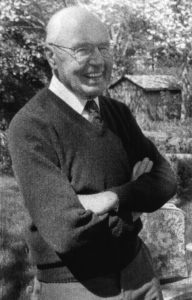 Geoffrey Cornish, a past president of the American Society of Golf Course Architects, began his career in 1935 and by 1980 had planned more courses in the New England states than any other architect in history. He is now a principal in Mungeam Cornish Golf Design, based in Uxbridge, Massachusetts. He’s designed, among many others, International Golf Club in Bolton, Massachusetts; Center Valley Club in Center Valley, Pennsylvania; and the Quechee Club in Quechee, Vermont. Cornish also designed, in Canada, Summerlea Golf and Country Club in Montreal, Quebec; and the New Ashburn Golf Course in Halifax, Nova Scotia.
Geoffrey Cornish, a past president of the American Society of Golf Course Architects, began his career in 1935 and by 1980 had planned more courses in the New England states than any other architect in history. He is now a principal in Mungeam Cornish Golf Design, based in Uxbridge, Massachusetts. He’s designed, among many others, International Golf Club in Bolton, Massachusetts; Center Valley Club in Center Valley, Pennsylvania; and the Quechee Club in Quechee, Vermont. Cornish also designed, in Canada, Summerlea Golf and Country Club in Montreal, Quebec; and the New Ashburn Golf Course in Halifax, Nova Scotia.
This story is typical of a period from the end of the Korean War in 1953 to around 1960. That period followed almost a quarter century of depression and war, starting with the stock market crash in 1929 and lasting until 1953.
I entered private practice in 1953 following seven years of working with renowned Canadian course architect Stanley Thompson and spending five years with the Canadian Army overseas, before five years of teaching at the University of Massachusetts.
By 1953 there were fewer golf courses in the United States than in 1929, while millions of servicemen and displaced persons had returned or were returning to their homelands. The world was in a state of flux. Nonetheless, intense interest in golf was apparent, but money to build new courses was inadequate.
An answer was “work in progress” layouts, which involved opening courses with many features, even important ones, missing – but with the intention of adding them when funds became available from memberships and green fees. The method worked, perhaps because families that had been scattered around the globe, often in peril, were happy to be together again on a course, finished or unfinished.
Probably there is a bit of a pioneer in each of us that revels in creating something out of nothing. Members also contributed to actual construction, often in stone-picking parties. Those work parties were also surprisingly successful, except when the keg of beer was opened too early. Many work in progress layouts eventually became fabulous, if plans were followed. Yet problems abounded for the course architect, mostly when committees promoting the course neglected to tell members that the layout would open, but unfinished.
I look on the guys and gals that tolerated these conditions and eventually achieved greatness as giants on earth, as were the course superintendents who maintained and enhanced the courses with limited funds.
